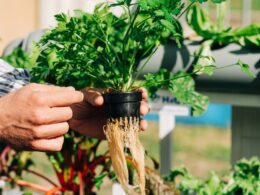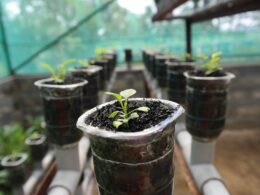Have you ever wondered what’s in your food, where it comes from, and how it’s grown? With the rise of hydroponic lettuce, these questions have become more pressing.
While hydroponic lettuce may seem like a healthy and sustainable option, there are some concerns that you should be aware of.
One of the main problems with hydroponic lettuce is the lack of nutrients compared to soil-grown lettuce. Hydroponic plants are often grown in nutrient-rich water, but they may not absorb all the necessary nutrients that soil-grown plants do. This could lead to a lack of essential vitamins and minerals in your diet.
Additionally, some hydroponic growers may use chemical fertilizers and pesticides that could pose health risks. It’s important to be aware of these issues and consider alternatives for your lettuce consumption.
Nutritional Concerns with Hydroponic Lettuce
You might be missing out on important nutrients when choosing to grow your greens using a hydroponic system. While hydroponic lettuce is often praised for its ability to grow faster and with less water than traditional farming methods, the nutrient balance of the lettuce can be affected.
Hydroponic lettuce is typically grown with nutrient solutions that are lacking in certain minerals and nutrients that are found in soil-grown lettuce. Research shows that hydroponic lettuce can have lower levels of vitamins and minerals, such as vitamin C, vitamin K, and calcium, compared to soil-grown lettuce. This can be a concern for individuals who rely on lettuce as a source of these important nutrients.
In addition, the flavor profile of hydroponic lettuce can differ from soil-grown lettuce, which can affect overall enjoyment of the vegetable. While hydroponic lettuce can be a convenient and sustainable option for growing greens, it’s important to consider the potential nutrient deficiencies and flavor differences.
If you choose to grow your lettuce hydroponically, be sure to supplement with additional nutrients and consider incorporating soil-grown lettuce into your diet to ensure a well-rounded nutrient intake.
Safety Issues with Hydroponic Lettuce
Now, let’s talk about some safety concerns you may want to consider when growing your own fresh greens at home. One of the biggest risks of hydroponic lettuce is contamination. Because the plants are grown in a water-based solution, any bacteria or pathogens that are present in the water can easily transfer to the lettuce. This can lead to serious foodborne illnesses, such as E. coli or salmonella.
To prevent contamination, it’s important to carefully monitor the water quality in your hydroponic system. Regularly test the pH and nutrient levels, and make sure to change the water frequently. Additionally, it’s a good idea to use a water treatment system to remove any harmful bacteria or pathogens.
Another safety concern with hydroponic lettuce is the use of pesticides and other chemicals. While hydroponic systems can be designed to minimize the need for pesticides, some growers may still use them to control pests and diseases. To ensure that your lettuce is free from harmful chemicals, it’s important to research the growing methods used by the supplier and to choose a reputable source for your plants.
Consider growing your own hydroponic lettuce at home to ensure that you have full control over the growing process and can avoid any potential safety risks.
Overall, hydroponic lettuce can be a safe and healthy addition to your diet, as long as you take the necessary precautions to prevent contamination and avoid exposure to harmful chemicals. By following good food safety practices and choosing your sources carefully, you can enjoy the benefits of fresh, nutrient-rich lettuce all year round.
Is the Main Problem in Hydroponics Related to Lettuce Production?
The main problem in hydroponics is often related to lettuce production. Although hydroponic systems offer controlled conditions, lettuce can be susceptible to diseases and pests, leading to reduced yields. Maintaining proper nutrient levels and temperature, along with implementing effective pest management strategies, are crucial for successful lettuce production in hydroponics.
Environmental Impact of Hydroponic Lettuce
When it comes to the environmental impact of hydroponic lettuce, there are two key points to consider: energy consumption and waste disposal.
You might be interested to know that hydroponic lettuce requires a significant amount of energy to maintain the ideal growing conditions.
Additionally, the waste generated by hydroponic systems can be harmful to the environment if not disposed of properly.
Energy Consumption
You’ll notice that growing lettuce using hydroponics requires a lot of energy, which can be draining on the environment and your wallet. Hydroponic systems need electricity to power water pumps, air pumps, and grow lights. These systems are designed to simulate the perfect growing environment for plants, which means that they need to maintain consistent temperature, humidity, and light levels. This requires a lot of energy.
Energy efficiency is an important consideration when it comes to hydroponic lettuce. You want to make sure that you’re not wasting energy and money on inefficient systems. You can do this by conducting a cost analysis of your hydroponic setup. Look at how much energy your system is using and how much it costs.
Then, look at ways to reduce your energy usage without compromising the health of your lettuce. By doing so, you can save money and reduce your environmental impact.
Waste Disposal
If you want to maximize the sustainability of your hydroponic system, it’s crucial to properly dispose of any waste materials generated during the growing process. Here are some recycling options and composting techniques you can use to ensure that your system remains eco-friendly:
-
Recycle any plastic containers or packaging materials used in the hydroponic system. These can be taken to local recycling centers or even reused in creative ways.
-
Consider composting any organic waste materials, such as spent nutrient solutions or plant trimmings. This not only reduces waste, but also creates a valuable soil amendment for other gardening projects.
-
Avoid disposing of any waste materials in landfills, as this can contribute to greenhouse gas emissions.
-
Research local regulations and guidelines for waste management to ensure compliance and proper disposal methods.
By taking these simple steps, you can ensure that your hydroponic system remains sustainable and environmentally friendly. Recycling and composting are easy ways to reduce waste and contribute to a healthier planet.
Alternatives to Hydroponic Lettuce
There are other options available for growing fresh greens that offer unique benefits. One of these alternatives is indoor farming, which can be done using traditional soil-based agriculture methods. This approach has been used for centuries and relies on natural soil, nutrients, and sunlight to produce healthy crops.
Soil-based agriculture has numerous advantages over hydroponic lettuce. First, soil is a natural medium that provides essential nutrients to plants, which helps them grow stronger and healthier. Secondly, soil-based agriculture can be done without the need for any synthetic fertilizers or pesticides, which can be harmful to the environment and human health. Finally, soil-based agriculture is a sustainable and cost-effective way to produce food, as it requires less energy and resources than hydroponic systems.
Another alternative to hydroponic lettuce is microgreens. These are young, tender plants that are harvested when they are just a few inches tall. Microgreens can be grown quickly and easily in a small space, making them an excellent choice for people who want to grow their own greens at home. They are also packed with nutrients and antioxidants, making them a healthy addition to any diet.
Overall, there are many alternatives to hydroponic lettuce that can provide you with fresh, healthy greens without the negative environmental and health impacts associated with hydroponic systems.
Future of Hydroponic Lettuce
If you’re interested in the future of hydroponic lettuce, there are a few key points you should be aware of.
First, there’ve been significant advances in nutrient management techniques that are allowing growers to produce healthier, more flavorful lettuce.
Second, there’s increasing regulation and oversight of hydroponic lettuce production, which’s helping to ensure that it’s safe for consumers to eat.
And third, there’s a growing demand for hydroponic lettuce as consumers become more interested in locally grown, sustainable produce.
Advances in Nutrient Management
You can improve the growth of your crops by utilizing new techniques for managing nutrients, ensuring that they receive the ideal balance of minerals and vitamins necessary for healthy growth. Advances in nutrient management have made it easier to provide the right nutrients to your hydroponic lettuce. Here are some techniques to consider:
-
Hydroponic nutrient solutions: These solutions are specifically designed to provide the right balance of nutrients for hydroponic plants. They’re available in liquid and powder form and can be customized to meet the needs of your plants.
-
Smart sensors: These can monitor the nutrient levels in your hydroponic system and adjust the nutrient solution accordingly. This ensures that your plants are receiving the right amount of nutrients at all times.
-
Precision farming: This involves using technology to optimize the growth of crops. It includes using sensors, drones, and other tools to monitor the health of your plants and adjust the environment as needed.
-
pH monitoring: Maintaining the right pH level is crucial for the health of your hydroponic lettuce. pH monitoring tools can help you keep track of the pH level and make adjustments as needed.
-
Organic nutrients: Many hydroponic growers are turning to organic nutrients to provide the right balance of minerals and vitamins. These are derived from natural sources like fish emulsion, kelp, and bone meal.
By utilizing these techniques, you can ensure that your hydroponic lettuce is receiving the right balance of nutrients for healthy growth. With the right nutrient management, you can increase your crop yield and produce healthier, tastier lettuce.
Regulation and Oversight
Now that you understand more about nutrient management in hydroponic lettuce, let’s dive into the importance of regulation and oversight. As a consumer, you want to feel confident that the lettuce you purchase is safe to eat, and that’s where industry standards and food labeling come into play.
In recent years, there have been concerns about the lack of regulation in the hydroponic industry. While hydroponic lettuce is generally considered safe to eat, there have been instances where growers have used harmful pesticides or failed to properly sanitize their equipment. This is why it’s important for the industry to have consistent standards and for growers to be held accountable for following them.
Additionally, clear food labeling can help consumers make informed decisions about the lettuce they purchase. By including information about the growing process, such as whether or not pesticides were used, consumers can make choices that align with their values and concerns about food safety.
Overall, regulation and oversight are essential to ensuring that hydroponic lettuce is both safe and transparent for consumers.
Frequently Asked Questions
How expensive is hydroponic lettuce compared to traditional lettuce?
Are you wondering about the cost of hydroponic lettuce compared to traditional lettuce? While hydroponic lettuce may be slightly more expensive, it’s important to consider the nutritional value it offers.
Hydroponic lettuce is grown in nutrient-rich water, which means it often contains more vitamins and minerals than traditionally grown lettuce. Additionally, traditional lettuce farming practices can have a negative impact on the environment due to the use of pesticides and excessive water consumption.
Hydroponic farming, on the other hand, uses less water and eliminates the need for harmful chemicals. So, while you may pay a bit more for hydroponic lettuce, the nutritional and environmental benefits are worth considering.
Can hydroponic lettuce be certified organic?
If you’re wondering whether hydroponic lettuce can be certified organic, the answer is yes.
While hydroponic farming doesn’t use soil, it does rely on nutrient solutions that can be certified organic.
In fact, hydroponic lettuce can have a higher nutrient content than traditional lettuce because the grower has direct control over the nutrients that the plants receive.
Additionally, since hydroponic farming takes place in a controlled environment, it’s easier to prevent contamination from pests and other environmental factors.
This means that hydroponic lettuce can be just as safe as traditional lettuce, if not safer.
What types of pesticides and chemicals are commonly used in hydroponic lettuce production?
When it comes to hydroponic lettuce production, the use of pesticides and chemicals is a common concern. However, there are alternatives to these chemicals that can be used to grow healthy lettuce.
These alternatives include biological controls, such as beneficial insects that eat harmful pests, and organic fertilizers, such as composted manure. By using these alternatives, the environmental impact of hydroponic lettuce production can be minimized.
It’s important to consider the impact of our food choices on the environment, and choosing lettuce grown with alternatives to chemicals is a step in the right direction.
How does the taste of hydroponic lettuce compare to traditional lettuce?
When it comes to taste, hydroponic lettuce can have a slightly different flavor compared to traditional lettuce. Some people find it to be more crisp and fresh, while others may find it to be less flavorful.
However, the nutrient content of hydroponic lettuce is often higher due to the controlled environment it’s grown in. This means that it can be a great option for those looking to boost their intake of vitamins and minerals.
Overall, while the taste may be slightly different, the nutrient benefits of hydroponic lettuce make it a healthy and safe choice for consumption.
Are there any potential health risks associated with consuming hydroponic lettuce?
When it comes to consuming hydroponic lettuce, there are potential health risks to keep in mind. One concern is the potential for contaminants, such as bacteria or pesticides, to be present in the growing environment. Additionally, there may be nutritional differences between hydroponic lettuce and traditional lettuce.
However, it’s important to note that these risks can be mitigated by carefully monitoring the growing process and following proper food safety guidelines. As with any food, it’s always a good idea to thoroughly wash your produce before consuming it.
By taking these precautions, you can enjoy the benefits of hydroponic lettuce without putting your health at risk.
Conclusion
So, what’s the verdict on hydroponic lettuce? Well, while it certainly has its advantages – such as its ability to be grown in small spaces and year-round – there are also some concerns to be aware of.
Firstly, there are potential nutritional issues with hydroponic lettuce, as it may not contain the same levels of nutrients as traditionally grown lettuce.
Secondly, there are safety concerns surrounding the use of pesticides and the risk of contamination.
Finally, there is also the environmental impact of the technology to consider, including its energy usage and waste production.
However, it’s important to note that there are alternatives to hydroponic lettuce, such as aquaponics or vertical farming, which may offer a more sustainable and environmentally friendly solution.
Ultimately, the future of hydroponic lettuce will likely depend on ongoing research and development aimed at addressing these concerns and improving the technology.









